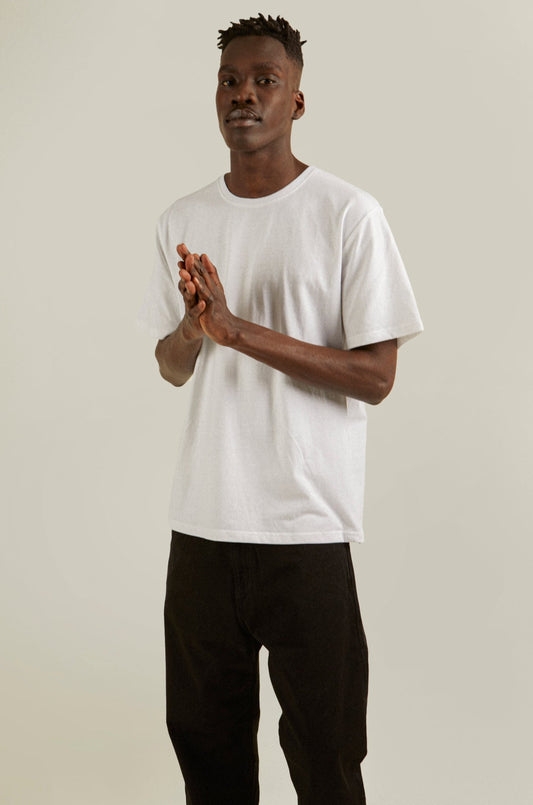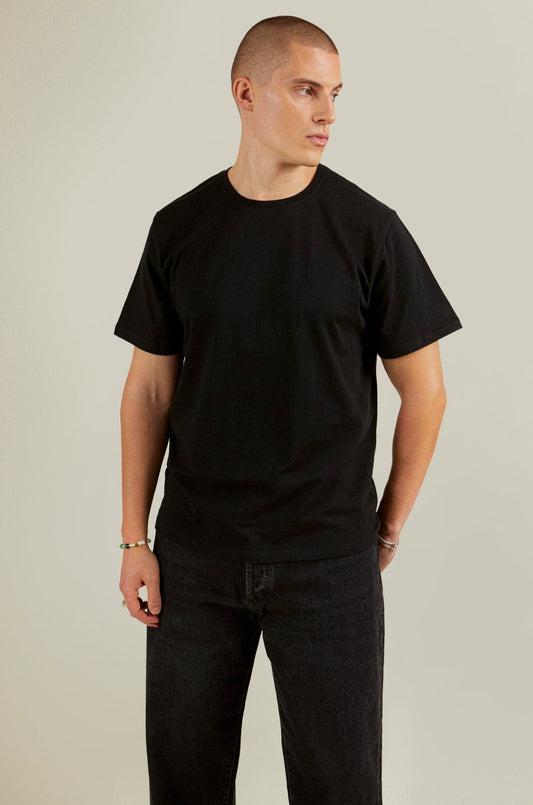The history of the t-shirt, now unisex and all-purpose, can be traced back to a time when males wore the garment as an undergarment. Cotton or linen T-shirts served as a barrier between the wearer's skin and whatever was worn on top of them throughout the Middle Ages. Easy to clean, these shirts shielded the skin from germs, and a gentleman's wealth was displayed by wearing a spotless, freshly cleaned shirt.
It's easy to forget the fact that the t-shirt is a relatively new phenomenon in the history of fashion. In the 19th century, the shirt tails were removed, and the shirt's body was thinned down to a more comfortable fit than the "T" shape of the shirt came to be established. Since that, the modern t-shirt has become a wardrobe staple. Thus it was the natural starting point for New Standard's 100% recycled essentials.
In this blog post, we investigate the history of this garment that had a profound impact on the fashion industry, spawned a new business of clothing decoration, and altered the way people communicated for the better.
From underwear to top - where it all got started
T-shirt-like clothing, like the tunic, may be traced back to ancient times, but the history of modern history as we know it is a comparatively new invention. Males and women (but primarily men) wore a button-down onesie called a "union suit" in the late nineteenth and early twentieth centuries in the United States. Yet, despite its ability to keep one warm in cold weather, it was not well-suited to hot or humid conditions.
Late 19th century workers would cut their jumpsuits in half to stay cool in hot weather. The t-shirt was born out of this practice. The first t-shirts were created between the Mexican-American War of 1898 and the U.S. The Navy started to use them as standard undershirts in 1913: their uniform included a loose-fitting flannel shirt with a square neck in 1880, and in 1913, a white cotton-knit t-shirt was approved as its official undergarments. Compared to the flannel, the cotton dried more quickly and was more comfortable to wear.
However, it wasn't until 1920 that the phrase "t-shirt" was officially added to the English vocabulary. F. Scott Fitzgerald was the first to use it in his novel This Side of Paradise. "So early in September Amory," writes Fitzgerald, "provided with 'six suits summer underwear, six suits winter underwear, one sweater or t-shirt, one jersey, one overcoat, winter, etc,' set out for New England, the land of schools."
Throughout the nineteenth century, the t-shirt underwent a number of noteworthy transformations. Using a new knitting technique, a more form-fitting garment could be made in large quantities, and the variety of fabrics available increased as well.
Knit-wool, t-shaped undershirts were acclaimed by hygiene experts for their ability to protect women from colds and other ailments, and they encouraged them to wear them instead of corsets. British sailors began wearing white flannel t-shirts under their woolen uniforms in the late 19th century. When the British Royal Navy started permitting sailors to wear these undershirts on the ship's deck around the end of the century, the working-class males swiftly embraced wearing t-shirts as outerwear during the weekends.
Dressing rebels, workers, and celebs in the 20th century
The next chapter in the history of the t-shirt traces its trail from the beginning of the mass production to some of the most iconic celebrities making the garment part of their signature look.
1910-1940
T-shirts were big business in the early part of the twentieth century. The P.H. Hanes Knitting Company began manufacturing men's underwear in 1901, while Fruit of the Loom started to mass-produce t-shirts in the 1910s. T-shirts had become the uniform of collegiate athletes by the 1930s, and in 1938, Sears, Roebuck & Company in the United States began selling white cotton "gob" shirts (slang for sailor shirts). According to their advertising, "It's an undershirt, it's an outer shirt," which was meant to assure men that they could "wear it as an outer shirt for sports and lounging, or as an undershirt — it's practical, correct either way". It was already closer to a modern plain t-shirt and the first one designed to be worn as an undergarment and an outer garment.
During World War II, the United States military and Navy provided their troops with white cotton T-shirts with short sleeves. The T-link shirts with heroic masculinity were popularized by wartime and postwar imagery of troops in t-shirts. In 1941, Sears declared, "You don't need to be a soldier to have your own personal t-shirt."
1950
Although they were widely available in department stores in the 1930s and 1940s, our look at the history of the t-shirt makes it clear that it wasn't until Hollywood heartthrobs wore them on the silver screen that the plain and simple garment started to gain popularity among people's wardrobes.
When rising method actors like Montgomery Clift (1951's A Place in the Sun), Marlon Brando (1953's The Wild One), and James Dean (1955's Rebel Without a Cause) began donning white t-shirts to signify their characters' rebelliousness, the t-shirt had officially entered the man's wardrobe as a garment that could be worn on its own outside of the workplace. Surprisingly or not, t-shirts wouldn't become acceptable business clothing for another 60 years or more.
Before this, the t-shirt was mainly seen as an undergarment worn beneath one's 'real' clothing and was rarely recognized as a standalone item. Brando and Dean did a better job than they ever could have anticipated in capturing the essence and elegance of what had previously been an unremarkable item of underwear. No matter how plain and simple, the type of t-shirt worn by the iconic actors already hinted at the disruptive potential of this piece of clothing. The way they wore the garment was almost a political statement and added sex appeal to it – soon, the t-shirt became a symbol of a youthful rebellion.
1960-1970
The next step in the history of the t-shirt was hallmarked by actors and singers, who began wearing t-shirts during the 1960s. Their appeal to stars was that when worn near to the skin, the t-shirt reveals the body. Artists like Mick Jagger were among the celebrities who continued on this pathway of increased sex appeal, started by Dean and Brando. The following decade saw the t-shirt become completely gender-neutral, and in 1977, Jacqueline Bisset's wet, see-through t-shirt in The Deep shocked American moviegoers.
In the mid-1960s, wrinkle-free cotton-polyester mixes were introduced to prove that shirts were no longer considered undergarments. In the early 1960s, innovations in silk-screen printing made it simple, fast, and affordable to print images onto shirts. Now consumers were able to get personalized, custom-made t-shirts. Once a piece of underwear, the t-shirt had soon evolved into an item of clothing that can be used to express anything from politics to advertising to graphics and humor. The outcomes were unique and frequently baffling. Favorite songs, surf brands, political leanings, and places visited were represented on the tees, such as "I Love NY".
Again when heat transfer printing became popular in the 1970s, the result was a slew of fanboy t-shirts depicting characters from Jaws, Star Wars, and Farah Fawcett. T-shirts like Coca-Cola shirts and Mickey Mouse shirts, and Keith Haring paintings were among the most famous print t-shirts created. T-shirts quickly became a popular marketing tool for businesses, musicians, and their management agencies.
1980-2000
Throughout history, the t-shirt has appealed to generations of singers, authors, actors, and intellectuals because of its association with the working class and the rebellious character of wearing an undergarment on the outside. Rappers such as N.W.A, pop stars like Backstreet Boys, and supermodels, including the likes of Kate Moss, performed and showed up in t-shirts in the 1990s.
While affordable, t-shirts are worn by a wide spectrum of people, designer t-shirts may be an unmistakable signal of conspicuous consumption. T-shirts have been popular since the 1950s, and numerous designers have reinvented the item since then, from Yves Saint Laurent and Dior in the 1970s to Chanel, Lacoste, Calvin Klein, and Polo Ralph Lauren in the 1990s. The T-shirt is a uniform worn by Giorgio Armani, Helmet Lang, and Nicolas Ghesquière.
The future of the t-shirt
T-shirts have gone a long way from their humble beginnings as utilitarian clothing over a century ago; it's difficult to imagine a wardrobe without one. Come the 2020s, t-shirts remain a way of telling the world who and what you are.
The most recent developments in the history of the t-shirt have sawn new innovative materials applied to producing what is perhaps the most universally loved and used piece of clothing. One of these approaches is New Standard's 100% recycled t-shirt manufactured from the textile industry's cutting waste to minimize the environmental impact of garment manufacturing.
With new innovations accelerating the shift towards a sustainable future spurring out to the market, the next generation in the rich history of the t-shirts will most likely be circular – meaning that they are made to be used more, made to be made again as well as made from safe and recycled or renewable inputs. How fast we can make it a reality and achieve a circular economy in fashion is up to the industry. However, one thing is certain: the t-shirt will be part of it.





